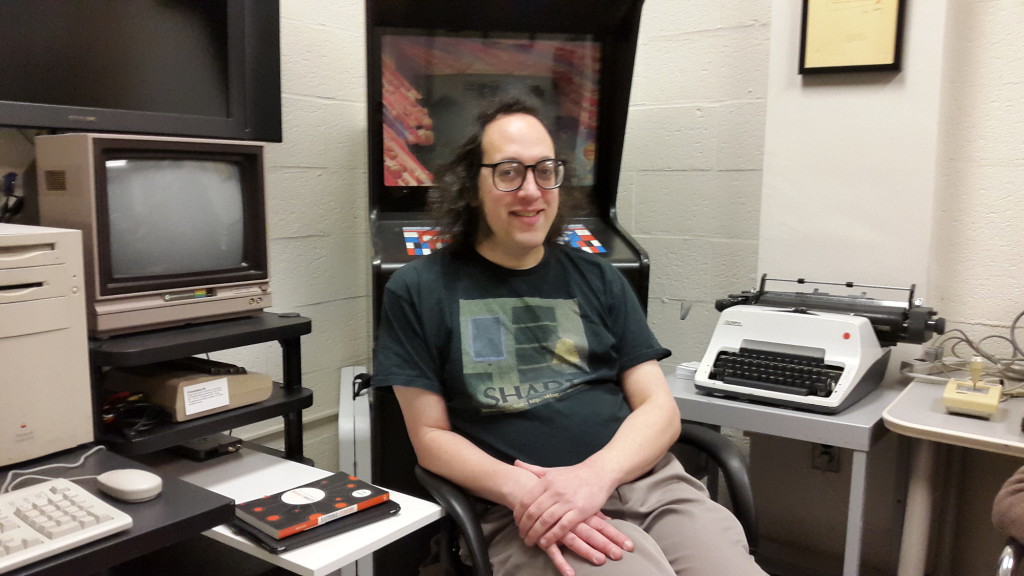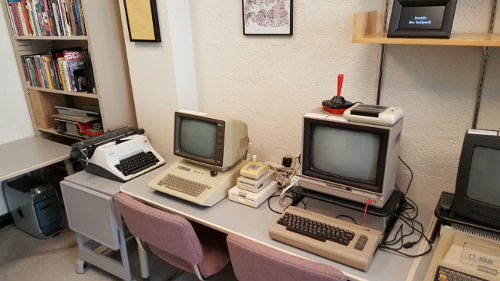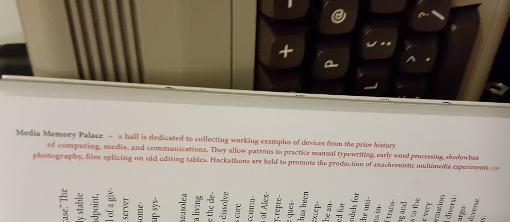“Renderings: Translating literary works in the digital age” by Piotr Marecki & Nick Montfort has been published, and is available online.
Tiny Trope Tank Productions
Recently, at the suggestion of our writer in residence, Milton Läufer, we in the Trope Tankt have been producing digital files for discussion at meetings. These productions, almost always computer programs but not constrained to be such, must be at most 256 bytes.
It’s been extremely productive in terms of thinking about digital media, platforms and programming languages, and how we approach creative projects — and even other projects — generally. Postdoctoral researcher Sofian Audry prompted us to discuss this some at the last meeting.
So far we have three sets of 256b files which have landed in this directory, organized by date and with file names that indicate who wrote what:
http://nickm.com/trope_tank/256/
They include work by RA Chris Kerich, who has produced rather demoscene-like visual effects using Python running in a terminal, and by postdoctoral researcher Angela Chang, who has provided short example programs for use in teaching. Angela’s examples show that you don’t have to have hypercompressed, confused code when you write short, interesting programs. You can value clarity and pedagogical usefulness if you like, or you can pack in as much as possible, for instance, in order to produce a visual effect.
Sofian has explored creative computing history by writing a 256b Commodore 64 BASIC program that implements, or at least strongly refers to, the classic Lemonade Stand BASIC program. Milton has generated various compelling visual displays. His and Chris’s most recent programs are less clearly mathematical and regular, instead imitating the natural world.
It was very apropos that Christian Bök pointed me to Dwitter, a framework for making tiny programs that can be easily shared on the Web, just recently. I’m sure we’ll all dig into that soon.
My pieces include one bash script, one Python 3 program, and an executable of 256b written in assembly for the Commodore 64. The Python 3 program is actually a very tiny text adventure, Wastes, and is listed on the Interactive Fiction Database. In fact, I’m pleased to see that at this point, it has one four-star (our of five) review!
Trope Tank Writer in Residence
The Trope Tank is accepting applications for a writer in residence during academic year 2016-2017.
Our mission is developing new poetic practices and new understandings of digital media by focusing on the material, formal, and historical aspects of computation and language. More can be discovered about the Trope Tank here:
The main projects of the Trope Tank for 2016-2017 are Renderings and Heftings, as I’ve described for a forthcoming article in _Convolutions 4_:
> The **Renderings** project is an effort to locate computational
> literature in languages other than English — poetry and other
> text generators, combinatorial poems, interactive fiction, and
> interactive visual poetry, for example — and translate this work
> to English. Along the way, it is necessary to port some of this
> work to the Web, or emulate it, or re-implement it, both in
> the source language and in English. This provides the original
> language community better access to a functioning version
> of the original work, some of which originates in computer
> magazines from several decades ago, some of which is from
> even earlier. The translations give the English-language
> community some perspective on the global creative work that has
> been undertaken with language and computation, helping
> to remedy the typical view of this area, which is almost always
> strongly English-centered.
> **Heftings,** on the other hand, is not about translation into
> English; the project is able to include translation between any
> pair of languages (along with the translation of work that is
> originally multilingual). Nor does it focus on digital and computational
> work. Instead, Heftings is about “impossible translation” of all
> sorts — for instance, of minimal, highly constrained,
> densely allusive, and concrete/visual poems. The idea is that
> even if the translation of such works is impossible, attempts at
> translation, made while working collaboratively and in conversation
> with others, can lead to insights. The Heftings project
> seeks to encourage translation attempts, many such attempts
> per source text, and to facilitate discussion of these. There is no
> concept that one of these attempts will be determined to be the
> best and will be settled upon as the right answer to the question
> of translation.
The Trope Tank’s work goes beyond these main projects. It includes developing creative projects, individually and collaboratively; teaching about computing, videogaming, and the material history of the text in formal and informal ways; and research into related areas. Those in the Trope Tank have also curated and produced exhibits and brought some of the lab’s resources to the public at other venues. The lab hosts monthly meetings of the People’s Republic of Interactive Fiction and occasional workshops.
There are no fees or costs associated with the residency; there is also no stipend or other financial support provided as part of the appointment. A writer in residence has 24-hour access to and use of the Trope Tank, including space to work, power and network connection, and use of materials and equipment. As a member of the MIT community, a writer in residence can access the campus and check out books from the MIT Libraries. We encourage our writer in residence to attend research and creative discussions and join us in project work and other collaborations, but this is not expressed with a particular requirement to be in the Trope Tank some amount of time per week.
To apply, email me, Nick Montfort, at moc.mkcin@mkcin with short answers (in no case to exceed 250 words each) to the following questions:
– What work have you done that relates to computation, language and literature, and the mission of the lab? Include URLs when appropriate; there is no need to include the URLs when counting words.
– How would you make use of your time in the Trope Tank? You do not have to offer a detailed outline of a particular project, but explain in some way how it would be useful to you to have access to the materials, equipment, and people here.
– What is your relationship, if any, to literary translation, and do you see yourself contributing to Renderings, Heftings, or both? If so, how?
– What connections could you potentially make between communities of practice and other groups you know, either in the Boston area or beyond, and the existing Trope Tank community within MIT?
Include a CV/resume in PDF format as an attachment.
Applications will be considered beginning on August 15; applicants are encouraged to apply by noon on that day.
We value diverse backgrounds, experiences, and thinking, and encourage applications by members of groups that are underrepresented at MIT.
“Textual Demoscene” by Piotr Marecki
A Trope Tank Technical Report (“Trope Report”) on the “Texual Demoscene” has just been posted. Here’s the abstract:
The demoscene is a mainly European subculture of computer
programmers, whose programs generate computer art in real time. The
aim of this report is to attempt a description of the textual
dimension of the demoscene. The report is the effect of efforts to
perform an ethnographic exploration of the Polish computer scene; it
quotes interviews with participants of demo parties, where text
plays a significant role: in demos, real-time texts, IF, mags or
digital adaptations. Media archeology focusing on the textual aspect
of the demoscene is important to understanding the beginnings of
digital literature and genres of digital-born texts.
Piotr Marecki really goes to the “ends of the earth” to investigate this, even reporting on a Polish demoscene production that is a text game and is called The Road to Assland. Here’s the full report.
Trope Tank Writer in Residence, Spring 2015

This Spring, Andrew Plotkin (a.k.a. Zarf) is the Trope Tank’s writer in residence. Andy will be at the Trope Tank weekly to work on one or more of his inestimable projects — as a game-maker, programmer, and platform developer, he has been working furiously for many years. (His home page is modest in this respect; See also his latest game, Hadean Lands.)
A “Trope Report” on Stickers
Not literally on stickers, no. This technical report from the Trope Tank is “Stickers as a Literature-Distribution Platform,” and is by Piotr Marecki. It’s just been released as TROPE-14-02 and is very likely to be the last report of 2014. Here’s the abstract:
Contemporary experimental writing often directs its attention to its writing space, its
medium, the material on which it is presented. Very often this medium is meaningful
and becomes part of the work – the printed text transfered to another media context
(for instance, into a traditional book) would become incomprehensible. Literature
distributed on stickers is a form of writing that is divided into small fragments of texts
(a type of constrained writing), physically scattered in different locations. One of the
newest challenges in literature are books with augmented reality, AR, which examine
the relation between the physical (the medium) and the virtual interaction. Sticker
literature is a rather simple analog form of augmented reality literature. The stickers
have QR codes or web addresses printed on them, so the viewer who reads/sees a
random sticker in the public space can further explore the text online. The viewer can
read other parts of the text on photographs (the photograph being another medium) of
other stickers placed in different locations. The author will discuss the use of stickers
throughout literary history, beginning with 20th century French Situationists, through
different textual strategies applied by visual artists and ending with literary forms such
as the sticker novel Implementation (2004) by Nick Montfort and Scott Rettberg or
Stoberskiade (2013). The author shall try to explain why writers decide to use this form,
how the text is distributed and received and how the city space is used in such projects.
This Speculative Musing
A Zine View of the Trope Tank
My most unconventional lab is documented in a new zine by Sherri Wasserman, one available for download and screen-viewing now; it will be available in DIY print-and-bind-your-own format soon.
The publication is Restore [Return] Shift, and it’s the second in a series of zines documenting spaces that preserve and offer access to creative computing.
A rare color photo can be seen on the Instragram announcement.
A Catalog of Trope Tank Warez
Thanks to RA Erik Stayton, we now have a formidable catalog of hardware and software in The Trope Tank, my lab at MIT.
There are pages on each of the systems (or in one case a group of switched systems) that are regularly hooked up and ready to use:
– Apple IIc System
– Atari 400 System
– Atari VCS System
– Commodore 64 System
– Macintosh SE System
– PowerMac G4 System
– Video Game Systems
Also, information is recorded about each display and about all the other working computers that are kept in the lab.
And while every last disk in the lab has not been cataloged, the VCS, Commodore 64, NES, Intellivision, and Odyssey cartridges and all packaged retail software on disk or CD-ROM are now listed in the extensive software catalog. For now, this catalog is presented as a simple, long Web page.
In other Trope Tank news, thanks to Jason Scott I’ve replaced a part in the Asteroids machine and the display no longer oscillates – the machine works perfectly.
The Trope Tank welcomes small classes, researchers, and artists and writers who are looking into the material properties of digital media. Please contact me if the lab’s resources can be of help to you. This Friday, while I will be out of town, Erik and Piotr Marecki (and a Commodore 64 system they are bringing) will be representing the lab at the MIT Museum and offering the public a view of how accessible and creative programming was in the early 1980s.
“Creative Material Computing in a Laboratory Context”
The Trope Tank has just issued a new technical report:
Creative Material Computing in a Laboratory Context
Nick Montfort and Natalia Fedorova
TROPE-12-03
Abstract
Principles for organizing a laboratory with material computing resources are articulated. This laboratory, the Trope Tank, is a facility for teaching, research, and creative collaboration and offers hardware (in working condition and set up for use) from the 1970s, 1980s, and 1990s, including videogame systems, home computers, an arcade cabinet, and a workstation. Other resources include controllers, peripherals, manuals, books, and software on physical media. In reorganizing the space, we considered its primary purpose as a laboratory (rather than as a library or studio), organized materials by platform and intended use, and provided additional cues and textual information about the historical contexts of the available systems.




![From Restore [Return] Shift](http://nickm.com/post/wp-content/stuff/TT_zine.jpg)
